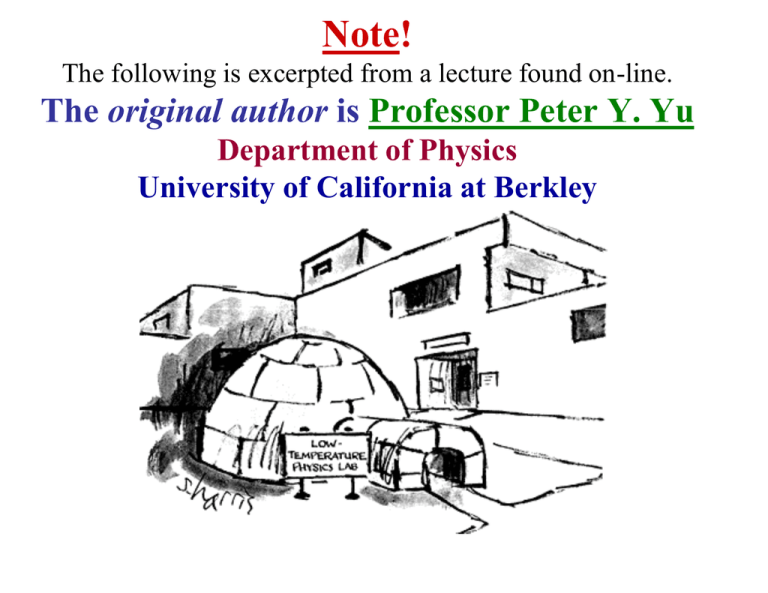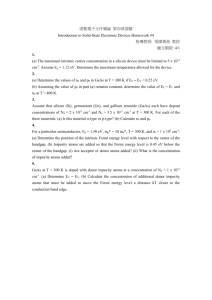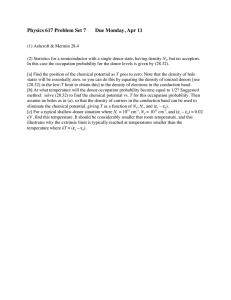Note! original author Professor Peter Y. Yu Department of Physics
advertisement

Note!
The following is excerpted from a lecture found on-line.
The original author is Professor Peter Y. Yu
Department of Physics
University of California at Berkley
Impurities & Defects
Effects on Semiconductor Devices
Outline: Point Defects
1. Shallow & Deep Impurities (“Centers”)
2. Examples of Deep Centers
a. Isoelectronic centers (a “good” defect!)
b. Fe in Si (a “bad” defect for solar cells).
3. Conclusions
“Human beings and semiconductors are
interesting because of their defects”*
*Peter Y.
Yu, U.C.-Berkeley
Defect Classification
by their Electronic Properties
1. Donors:
Examples: PSi in Si, SiGa in GaAs
2. Acceptors:
Examples: BSi in Si, SiAs in GaAs
3. Isovalent or Isoelectronic:
Example: NP in GaP
4. Amphoteric:
Example: Si in GaAs
SiGa is a donor, SiAs is an acceptor.
5. Vacancies & Interstitials
Hydrogenic or “Shallow” Defects
• Consider a single donor impurity, such as P substituting for Si.
– There is one extra valence electron e- in P in comparison to Si.
– This e- is very weakly bound to P+ by the
Screened Coulomb Potential: V = -[(e2)/(εr)]
ε = Material dielectric constant. This accounts for the screening of the
impurity potential by the valence electrons.
• The Schrödinger Equation for that e- is “equivalent” to that for an
Effective “Hydrogen Atom”
{(p2)/(2m*) - (e2)/(εr)]}ψ(r) = Eψ(r)
m* = The effective mass of the electron in the conduction band.
• This approach is therefore known as the
Effective Mass Approximation
• It is also known as the
Effective Hydrogen Atom Approximation
“Hydgrogenic” Impurity Levels
• Just as in the Hydrogen Atom, the energy eigenvalues E
for the donor energy levels form a Rydberg series.
Because of this, they are called
“Hydgrogenic” Levels
They have the form:
En = E – (R*)/(n2) (n = 1,2,3,4,.)
where the Effective Rydberg constant is
R* = (m*/m)(13.6 eV)/(ε)2
E Energy when the e- becomes free (ionized in H).
This is the conduction band edge in semiconductors.
R* Energy to ionize the electron in the ground state.
“Hydgrogenic” Impurity Levels
• “Hydgrogenic” Impurity Levels for a single donor electron
have the form:
En = E – (R*)/(n2) (n = 1,2,3,4,.)
the effective Rydberg constant is
R* = (m*/m)(13.6 eV)/(ε)2
E Energy of the conduction band edge in semiconductors.
R* Energy to ionize the electron in the ground state.
• Using the above equation, the binding energy of the e- in the
1s level of the donor ion is ~ 10-100 meV in semiconductors.
It is that small because, generally m* << m and ε >> 1.
• For this effective “Hydrogen Atom”, there is also an
effective “Bohr radius”, a* = ε(0.5Å)(m/m*)
a* is a measure of the average distance that the 1s donor electron can
move in the lattice away from the donor atom. Typical numbers give:
a* > 10Å. This is a large distance (several lattice spacings)!
“Hydrogenic” Donor Levels
Schematic Diagram of
hydrogenic donor levels
in the bandgap region
of a direct gap material
• Note that, since the donor levels are a few meV & the
bandgap Eg is in the eV range, this diagram is obviously
8
NOT to scale!!
Comparison:
Measured Shallow Donor & Acceptor Levels
& Effective Mass Approximation Predictions
in some compound semiconductors
9
Two “Local Factors”
which help to determine defect properties are
1. The chemical nature of the defect
2. The defect “size”.
• Impurities with d & f valence electrons tend to retain
their atomic nature in the material. That is, the electron is
localized
– & doesn’t travel very far from it’s donor atom.
• Impurities with a large size difference from the host
–
atoms tend
to induce (sometimes very large!)
Lattice Relaxation.
• Defects involving dangling bonds (e.g. vacancies) also
tend to induce (sometimes very large!)
Lattice Relaxation.
10
Deep Levels or “Deep Centers”
• The binding energies E of hydrogenic donor or acceptor
impurities are typically < 100 meV & therefore E << Eg,
where Eg is the host material bandgap.
So these impurities are also labeled as
Shallow Impurities or Shallow Levels.
The earliest understanding was that defects which produce
energy levels where the Effective Mass (hydrogenic)
Approximation is not valid were known as
Deep Centers or Deep Levels.
It was assumed that these defects always produced levels E in the
host bandgap of the order of ~ (½)Eg from a band edge. The more
–
recent, modern understanding is that deep centers may have energy
–
levels in the bandgap which can be close to either the conduction
band edge or the valence band edge. It turns out that, for such defects,
11
lattice relaxation effects can be important.
Qualitative reasons for Lattice Relaxation
Host atoms may have to change their equilibrium positions (displace from
equilibrium) in order to accommodate defects. For example, this happens if the size
of the impurity atom is either >> larger than the size of the host atom it displaces or
if the impurity atom size is << the size of the host atom. The most severe case of
this happens if there is a vacancy. In that case, the host lattice tends to form new
bonds so that there are no “dangling bond “defects left. The figure shows a
schematic of what happens when there is a vacancy in Si.
12
Energy Considerations in Lattice Relaxation
• It costs a small amount in energy to displace atoms (~phonon
energy for small displacements) but this more than balanced
out by the gain in lowering the electronic energy.
• The details of all of this are complex & beyond the scope of
this course. They involve so-called “Negative & Centers” and
Jahn-Teller distortions.
• There also can be strong electron-phonon coupling as in
molecules
• The configuration and the size of the atomic displacements
from equilibrium are determined by a complex balance
between electronic and lattice energies and therefore are
difficult to predict.
• These displacements also depend strongly on the charge state
of the defect.
13
Deep Centers with Small Binding Energies & Lattice Relaxation
Isoelectronic Traps
• Consider substitutional NAs in GaAs and GaAsP (alloy):
N has the same valence as As or P so there is
•
•
•
•
No Coulomb Potential & thus No shallow donor or acceptor
hydrogenic levels! There also are no dangling bonds.
Can there be bound states? (Can there be levels in the bandgap?)
N is much more electronegative than P and As. The
electronegativity of N = 3 and for P = 1.64, respectively. This
means that electrons are more attracted to N than to P or As.
This impurity potential is short-ranged and weak
A small binding energy is expected
(the level in the bandgap is expected to be near a band edge).
• A simple approximation to this potential would be a δ-function
Although potential is shallow, it is highly localized
14 nature The EMA is not a good approximation.
N in GaP & GaAs
An Example of a “Good” Deep Center
• The short-ranged potential means that the wavefunction
in r space will be highly localized around the N.
The electron wavefunction is spread out in k-space.
Although GaP is an indirect bandgap material, the optical
transition is very strong in GaP:N
Red LED’s used to be made from GaP:N
It turns out that a large amount of N can be introduced
into GaP but only small amount of N can be introduced
into GaAs because of a larger difference in atomic sizes.
14
N in GaP
A “Good” Deep Center
• The N impurity in GaP is a “good” deep center because it
makes GaP:N into a material which is useful for lightemitting diodes (LED).
• GaP has an indirect band gap so, pure GaP is not a good
material for LED’s (just as Si & Ge also aren’t for the same reason).
• It turns out that the presence of N actually enhances the
optical transition from the conduction band to the N level
which makes GaP:N an efficient emitter.
• So, GaP:N was one of the earliest materials for red LED’s.
• More recently, GaP:N has been replaced by the
13more efficient emitter: GaInP (alloy).
The GaAsP Alloy with
N Impurities
Interesting,
beautiful data!
The N impurity level is a
deep level in the bandgap
in GaP but it is a level
resonant in the conduction
band in GaAs. The figure
is photoluminescence data
in the alloy GaAsxP1-x:N
under large hydrostatic
pressure for various alloy
compositions x.
13


